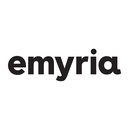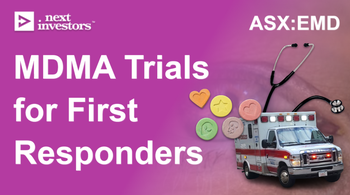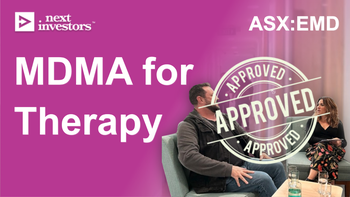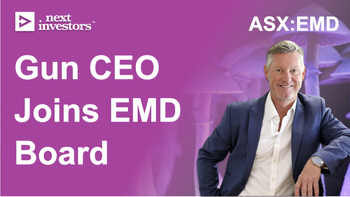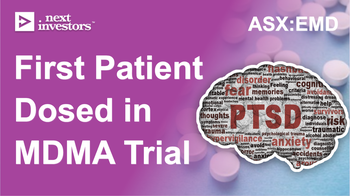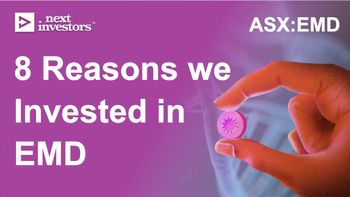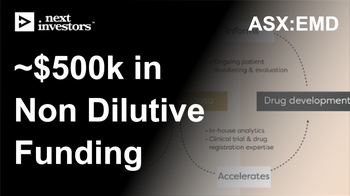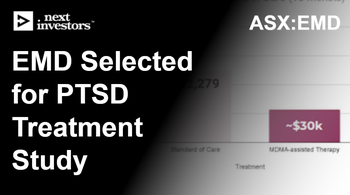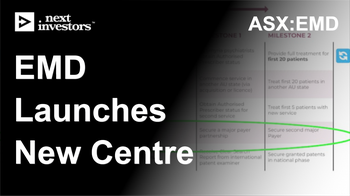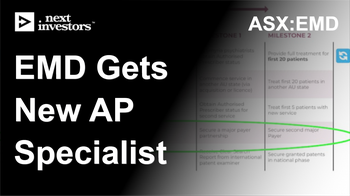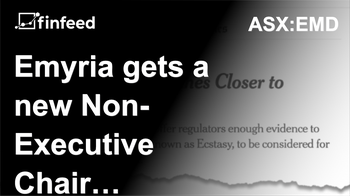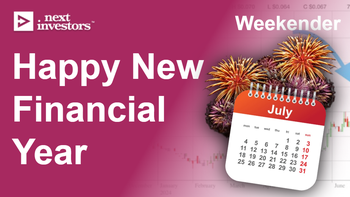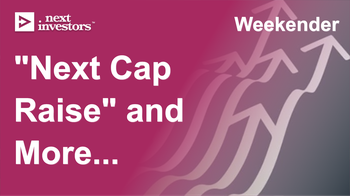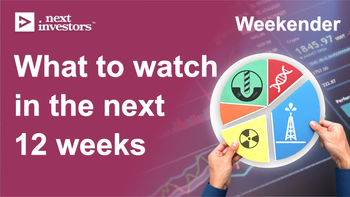Investment Memo:
Emyria
(ASX:EMD)
-
LIVE
Opened: 04-Sep-2023
Shares Held at Open: 5,666,667
What does EMD do?
Emyria (ASX: EMD) is an integrated clinical drug development and care delivery company.
EMD’s primary area of focus is on psychedelic assisted therapies using MDMA, ketamine and psilocybin to treat difficult mental health problems in innovative ways. It also has cannabidiol (CBD) treatments in its clinical pipeline for anxiety and complex pain.
What is the macro theme?
We think psychedelic assisted therapy and psychedelic clinical trials have the potential to reshape care and treatments for difficult to treat neuropsychiatric disorders such as complex trauma, depression, anxiety, chronic pain and Parkinson’s disease.
As more patients become aware of their options, and the regulatory environment eases, we think companies that can deliver these types of treatments, services and clinical trials will attract capital.
Why did we invest in EMD?
Australia leading the charge globally in new age treatments for mental health
Following the Therapeutic Goods Administration’s decision, which came into force in July 2023, Australia now has the regulatory environment needed for a company like EMD to work.
This decision put EMD and Australia potentially years ahead of other jurisdictions like the US.
EMD at the forefront of psychedelic assisted treatment
EMD has the infrastructure needed to provide psychedelic treatments.
EMD owns actual brick and mortar clinics where patients are treated.
These clinics are where practitioners like psychiatrists work - currently under TGA rules, these treatments can only be prescribed by specifically authorised psychiatrists.
EMD is creating novel MDMA products
EMD has partnered with UWA to develop a number of different novel MDMA treatments to harness the therapeutic aspects of the drug - in particular with Parkinson’s disease.
Drug development can be very lucrative, if EMD proves that it is safe and effective in a clinical setting.
EMD’s unparalleled access to patient data and AI partnership
Through its clinics EMD has access to opt-in patient data and uses state of the art data insights generated by a technology platform called Palantir Foundry. This data is used to inform better care practices and drug development opportunities.
Clinics delivering revenue
EMD provides mental health care services to patients, which generates revenue for the company and subsidises its R&D. The company made $1.6M last FY, targeting $5.7M this FY.
CBD “Side bets” provides a catalyst
EMD is currently in a Phase 3 clinical trial for an over-the-counter CBD treatment for anxiety.
The company has a commercial partner lined up to oversee marketing, distribution and sales. Any positive outcome here will drive immediate value back to EMD shareholders.
EMD management ‘dream team’
We think EMD’s Board and Management are highly qualified, well respected and provide the necessary governance structure to support a far larger organisation.
EMD’s market cap provides an attractive entry point
At our Initial Entry Price of 7.5 cents, EMD has a market cap of ~$25M. Other operators in the space are capped at many multiples of EMD, indicating plenty of room for growth.
What do we expect EMD to deliver?
Objective #1: Gather important data from MDMA mental health trial
We want to see EMD deliver its MDMA assisted therapy. EMD has already recruited its first patient and secured key approvals from the Office of Drug Control and Therapeutic Goods Administration.
Milestones
 Begin treatment on first patient (MDMA)
Begin treatment on first patient (MDMA)
 Complete patient recruitment for Phase 2b trial (MDMA)
Complete patient recruitment for Phase 2b trial (MDMA)
 Complete Phase 2b trial for MDMA
Complete Phase 2b trial for MDMA
Objective #2: Develop novel MDMA treatments
We expect EMD to continue its clinical trial work and drug development, which includes preclinical tests on MDMA analogues (animal studies) for faster acting MDMA and MDMA “without the high” for Parkinson’s disease.
Milestones
 Animal study results for fast acting MDMA analogue
Animal study results for fast acting MDMA analogue
 Animal study results for Parkinson’s MDMA analogue
Animal study results for Parkinson’s MDMA analogue
 Identify lead drug candidates for Phase 1 trial
Identify lead drug candidates for Phase 1 trial
Objective #3: Expand mental health treatments to psilocybin and ketamine therapies
We want to see EMD expand its assisted therapy programs to psilocybin and ketamine.
Milestones
 Secure key approvals for psilocybin use
Secure key approvals for psilocybin use
 Secure psilocybin supply
Secure psilocybin supply
 Begin treatment on first patient (psilocybin)
Begin treatment on first patient (psilocybin)
 Develop ketamine assisted therapy protocol
Develop ketamine assisted therapy protocol
 Begin treatment on first patient (ketamine)
Begin treatment on first patient (ketamine)
Objective #4: CBD “Side bet” clinical trials
Whilst we didn't necessarily Invest for its CBD clinical trials, a successful outcome will deliver immediate value to shareholders.
EMD is currently in a Phase 3 trial for its CBD over the counter treatment for stress and anxiety.
It has a commercialisation agreement in place with Aspen Australia if the trial is successful and the drug is registered with the TGA.
EMD is also developing a highly potent CBD treatment for complex pain & anxiety to take to Phase 1 trials.
Milestones
 Results for the Phase 3 trial for low-dose CBD for stress and anxiety
Results for the Phase 3 trial for low-dose CBD for stress and anxiety
 Register CBD treatment with the TGA for over the counter use
Register CBD treatment with the TGA for over the counter use
 Begin: Phase 1 trial of high-potency CBD treatment
Begin: Phase 1 trial of high-potency CBD treatment
 Results: Phase 1 trial of high-potency CBD treatment
Results: Phase 1 trial of high-potency CBD treatment
Objective #5: Scale clinical health services & engage payers
We want to see EMD open new clinics and/or licence its treatments and care models to create scale. To do this we expect EMD to get a major payer in healthcare or an industry body to help fund treatments.
Milestones
 Open a new clinic
Open a new clinic
 Licence a care model
Licence a care model
 Secure a major payer
Secure a major payer
Objective #6: Expand Intellectual Property and build partnerships
EMD needs to secure further patent protection for its treatments (such as MDMA analogues), continue to work with major healthcare bodies to support registration of its treatments and find commercialisation partners.
Milestones
 Patent application
Patent application
 Patent grant
Patent grant
 Commercialisation partner secured
Commercialisation partner secured
Adverse patient outcome risk
Given the psychedelic therapies that EMD will administer are still being fully understood, there could be a greater risk of adverse patient outcomes.
Were adverse patient outcomes to occur, aside from the direct negative impact to patients, it is possible the media and social sentiment could turn on the industry and EMD.
Alternatively, this could happen even if EMD does everything properly, i.e another less scrupulous business or operator attracts negative publicity.
Regulatory risk
The regulatory changes that allow EMD to operate in the field of psychedelic therapies are new and could be reversed. A regulator could step in and intervene either across the industry or specifically in relation to EMD. A change of government could also bring about a regulatory reversal.
Competition risk
EMD will need to move quickly to establish its presence in the market. If progress is slow, another care provider or alternative treatments could emerge hurting EMD’s prospects.
Clinical trial risk
There is a chance that one or more of EMD’s clinical trials fail to meet their primary or secondary endpoints, meaning the treatments fail to satisfy the criteria of the studies. Any clinical trial results, if negative, could hurt the EMD share price.
Funding risk
Small caps often need to raise cash to fund their growth. Whilst EMD is generating revenue now, it is still making a loss - i.e. it spends more cash than it brings in. If EMD is unable to develop a self-sustaining business model with positive operating cash flow, this could force EMD to raise capital in the future, likely at a discount to market prices to secure funds.
Market risk
There is always the possibility that broader market sentiment gets worse and shares as a whole trade lower, taking EMD’s share price with it. Alternatively, there could be further sector specific pain ahead. For example, the biotech sector sells down.
What is our investment plan?
Our Investment Plan for EMD is to hold on to a majority of our position to see the company execute on its business strategy over the next two to three years.
If the company’s share price materially re-rates in the medium term due to the results of the CBD Phase 3 trial, a breakthrough in the MDMA technology, a macro triggering event or any other unknown reason, we may look to sell up to ~20% of our holding. See our general hold policy for more details.
We also intend to fully participate in the EMD rights issue.
Disclosure: Disclosure: S3 Consortium Pty Ltd (the Company) and Associated Entities own 5,666,667 EMD shares and 2,833,334 EMD options at the time of publishing this memo. The Company has been engaged by EMD to share our commentary on the progress of our Investment in EMD over time.

